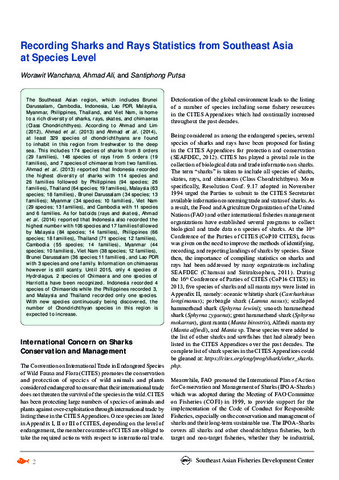Recording sharks and rays statistics from Southeast Asia at species level
Share
Abstract
The Southeast Asian region, which includes Brunei Darussalam, Cambodia, Indonesia, Lao PDR, Malaysia, Myanmar, Philippines, Thailand, and Viet Nam, is home to a rich diversity of sharks, rays, skates, and chimaeras (Class Chondrichthyes). According to Ahmad and Lim (2012), Ahmad et al. (2013) and Ahmad et al. (2014), at least 329 species of chondrichthyans are found to inhabit in this region from freshwater to the deep sea. This includes 174 species of sharks from 8 orders (29 families), 148 species of rays from 5 orders (19 families), and 7 species of chimaeras from two families. Ahmad et al. (2013) reported that Indonesia recorded the highest diversity of sharks with 114 species and 26 families followed by Philippines (94 species; 26 families), Thailand (64 species; 19 families), Malaysia (63 species; 18 families), Brunei Darussalam (34 species; 13 families); Myanmar (34 species; 10 families), Viet Nam (29 species; 13 families), and Cambodia with 11 species and 6 families. As for batoids (rays and skates), Ahmad et al. (2014) reported that Indonesia also recorded the highest number with 106 species and 17 families followed by Malaysia (84 species; 14 families), Philippines (66 species; 18 families), Thailand (71 species; 12 families), Cambodia (55 species; 14 families), Myanmar (44 species; 10 families), Viet Nam (38 species; 12 families), Brunei Darussalam (36 species; 11 families), and Lao PDR with 3 species and one family. Information on chimaeras however is still scanty. Until 2015, only 4 species of Hydrolagus, 2 species of Chimaera and one species of Harriotta have been recognized. Indonesia recorded 4 species of Chimaerids while the Philippines recorded 3, and Malaysia and Thailand recorded only one species. With new species continuously being discovered, the number of Chondrichthyan species in this region is expected to increase.
Suggested Citation
Wanchana, W., Ali, A., & Putsa, S. (2016). Recording sharks and rays statistics from Southeast Asia at species level. Fish for the People , 14(1), 2-6. http://hdl.handle.net/20.500.12066/981


